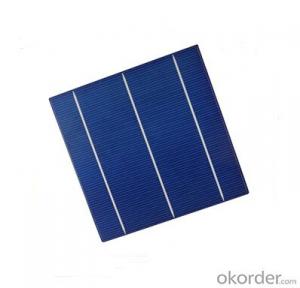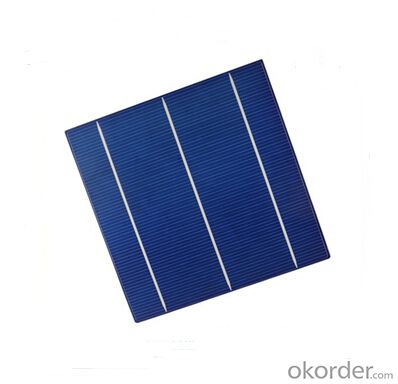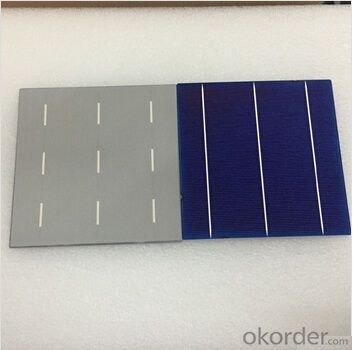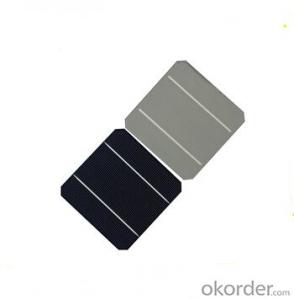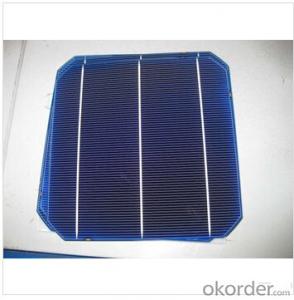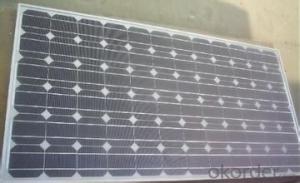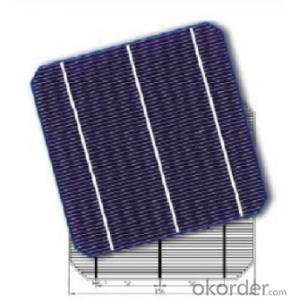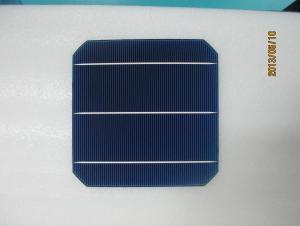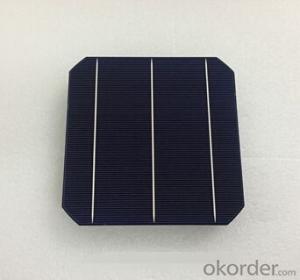Spectrolab Xtj Monocrystalline Solar Cell 156mm*156mm±0.5mm
- Loading Port:
- Shanghai
- Payment Terms:
- TT OR LC
- Min Order Qty:
- 3000 pc
- Supply Capability:
- 300000 pc/month
OKorder Service Pledge
OKorder Financial Service
You Might Also Like
Solar Cells:
solar cells, when struck by photons of light from the sun, generates an electrical current which can then be used to power DC or AC electrical loads.
A solar cell is made of silicon. Computer chips are made of this same material. Basically, when light strikes the surface of a solar cell some of it is absorbed into the silicon. This light energy bumps the electrons loose and causes energy to flow
Solar cells is made by solar wafer, it has three categories of solar cell right now, monocrystalline polycrystalline and thin film,These cells are entirely based around the concept of PN junction, which is the critical part of solar module, it is the part that can convert the light energy into electricity, the thickness is from 180um to 200um, with even busbars to conduct electricity, textured cell can decrease diffuse reflection; they are often electrically connected and encapsulated as a module. Photovoltaic modules often have a sheet of glass on the front (sun up) side, allowing light to pass while protecting semiconductor wafers from abrasion and impact due to wind-driven debris, rain, hail, etc. Solar cells are also usually connected in series in modules, creating an additive voltage. Connecting cells in parallel will yield a higher current;With high quality and stable quality. Our Cells can greatly improve the performance of Solar Modules.
Features:
High efficiencies up to 16.4%
Proven long term mechanical stability of silicone
Make of highly purified poly silicone
Three bus bars for reduced series resistance and improved module and cell efficiency
Blue anti-reflecting coating ensures improved light absorption and increased efficiency
Acid texturization offers a uniform appearance and virtually invisible crystal structure
Excellent low light behavior for improved energy yield
Specifications
Cells | Monocrystalline Solar Cell | Intensity[W/m2] | Isc *[mA] | Voc*[mV] | ||||||
Format | 156mm*156mm±0.5mm | 1000 | 1 | 1 | ||||||
Thickness | 190um±20um | 900 | 0.9 | 0.994 | ||||||
Front(-) | 1.4mm bus bars (silver), | 500 | 0.5 | 0.969 | ||||||
blueanti-reflectingcoating (silicon nitride) | 300 | 0.3 | 0.946 | |||||||
Back(+) | 3mm wide soldering pads (silver) | 200 | 0.2 | 0.926 | ||||||
Back surface field (aluminium) | ||||||||||
Electrical typical values | ||||||||||
Product model | Eff. % | Pmax (W) | Vpm(V) | Ipm (A) | Voc(V) | Isc(A) | ||||
18.20%-4.429W | EFF≥18.20% | Pmax ≥4.429 | 0.535±3 | 8.2785 | 0.636 | 8.815 | ||||
18.00%-4.380W | 18.20%>EFF≥18.00% | 4.429>Pmax ≥4.380 | 0.534±3 | 8.2022 | 0.635 | 8.753 | ||||
17.80%-4.332W | 18.00%>EFF≥17.80% | 4.380>Pmax ≥4.332 | 0.533±3 | 8.1088 | 0.634 | 8.704 | ||||
17.60%-4.283W | 17.80%>EFF≥17.60% | 4.332>Pmax ≥4.283 | 0.531±3 | 8.0662 | 0.633 | 8.620 | ||||
17.40%-4.234W | 17.60%>EFF≥17.40% | 4.283>Pmax ≥4.234 | 0.530±3 | 7.9896 | 0.632 | 8.610 | ||||
17.20%-4.186W | 17.40%>EFF≥17.20% | 4.234>Pmax ≥4.186 | 0.529±3 | 7.9127 | 0.631 | 8.529 | ||||
17.00%-4.137W | 17.20%>EFF≥17.00% | 4.186>Pmax ≥4.137 | 0.527±3 | 7.8503 | 0.630 | 8.459 | ||||
16.80%-4.088W | 17.00%>EFF≥16.80% | 4.137>Pmax ≥4.088 | 0.524±3 | 7.8024 | 0.629 | 8.397 | ||||
16.60%-4.040W | 16.80%>EFF≥16.60% | 4.088>Pmax ≥4.040 | 0.521±3 | 7.7539 | 0.627 | 8.239 | ||||
16.40%-3.991W | 16.60%>EFF≥16.40% | 4.040>Pmax ≥3.991 | 0.519±3 | 7.6900 | 0.625 | 8.198 | ||||
16.20%-3.942W | 16.40%>EFF≥16.20% | 3.991>Pmax ≥3.942 | 0.516±3 | 7.6404 | 0.623 | 8.153 | ||||
16.00%-3.894W | 16.20%>EFF≥16.00% | 3.942>Pmax ≥3.894 | 0.514±3 | 7.5754 | 0.620 | 8.145 | ||||
Solar Cells Advantage:
1. High efficiency and High power.
2. Long-term electrical stability.
3. Lowest price and Fastest delivery.
4. Good quality and good service.
5.Bulk supply
6. Good Warranty
7.Big Sale
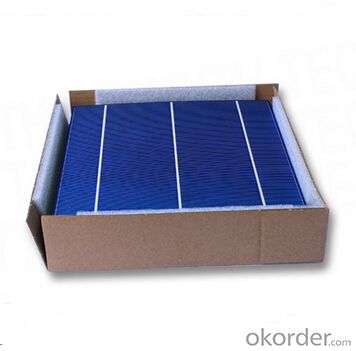
FAQ
We have organized several common questions for our clients,may help you sincerely:
1, What’s price per product ?
A: It’s depends on the quantity, delivery date and payment terms of the order. We can talk further about the detail price issue. Our products is high quality with lower price level.
2, How to make payment?
We accept T/T or L/C.
3, What is your lead time?
Generally 1-5 weeks depends on the order quantity and your specific requirements.
4, Can you do OEM for us?
Yes, we can.
5, How do you pack your products?
We have rich experience on how to pack the panels to make sure the safety on shipment when it arrives at the destination.
- Q: What is the average lifespan of a solar cell?
- The average lifespan of a solar cell is typically around 25 to 30 years.
- Q: How do solar cells perform in areas with frequent earthquakes?
- Solar cells can generally perform well in areas with frequent earthquakes as they do not have any moving parts and are not typically affected by ground vibrations. However, it is essential to ensure that the solar panels are properly installed and secured to withstand potential damages caused by seismic activities. Additionally, regular maintenance and inspections may be necessary to ensure the structural integrity of the solar system in earthquake-prone areas.
- Q: How many solar cells are there in a solar panel?
- Maybe 15 or more.
- Q: Can solar cells be used for off-grid applications?
- Yes, solar cells can be used for off-grid applications as they convert sunlight into electricity and can be utilized in remote areas or places lacking access to the traditional power grid. They provide a sustainable and reliable source of energy for powering various off-grid applications such as cabins, RVs, boats, and remote communication systems.
- Q: Can solar cells be used in remote sensing devices?
- Yes, solar cells can be used in remote sensing devices. Solar cells convert sunlight into electricity, which can power various sensors and data collection devices used in remote sensing applications. The use of solar cells ensures that these devices can operate independently and sustainably in remote locations without the need for external power sources.
- Q: Can solar cells be used to power refrigeration systems?
- Yes, solar cells can be used to power refrigeration systems. Solar cells convert sunlight into electricity, which can then be used to power various appliances, including refrigeration systems. This is particularly useful in off-grid or remote areas where access to conventional power sources may be limited.
- Q: Can solar cells be used in harsh climates?
- Yes, solar cells can be used in harsh climates. While extreme temperatures, snow, and dust can potentially affect the efficiency and performance of solar cells, advancements in technology and design have made them more resilient. Specialized coatings, materials, and mounting systems are employed to protect solar cells from harsh weather conditions. In fact, solar panels are increasingly being used in various extreme climates around the world, including deserts and polar regions, proving their adaptability and effectiveness even in challenging environments.
- Q: How do solar cells perform in high humidity environments?
- Solar cells can still perform efficiently in high humidity environments. However, prolonged exposure to high humidity can slightly decrease their overall efficiency due to the moisture affecting the cell's performance and the build-up of dirt and dust particles. Regular cleaning and maintenance can help mitigate these effects and ensure optimal performance.
- Q: Can solar cells be used in hot climates?
- Yes, solar cells can be used in hot climates. In fact, solar cells are more efficient in hot climates due to increased sunlight and higher temperatures, which can enhance their overall performance. However, it is important to consider proper maintenance and cooling mechanisms to prevent any potential damage or decrease in efficiency caused by excessive heat.
- Q: Can solar cells be used in shopping malls?
- Yes, solar cells can be used in shopping malls. In fact, many shopping malls around the world have already adopted solar panel systems to generate clean and renewable energy. These solar cells can be installed on rooftops, parking lots, or even as shading structures in outdoor areas, helping to reduce electricity costs and environmental impact.
Send your message to us
Spectrolab Xtj Monocrystalline Solar Cell 156mm*156mm±0.5mm
- Loading Port:
- Shanghai
- Payment Terms:
- TT OR LC
- Min Order Qty:
- 3000 pc
- Supply Capability:
- 300000 pc/month
OKorder Service Pledge
OKorder Financial Service
Similar products
Hot products
Hot Searches
Related keywords
